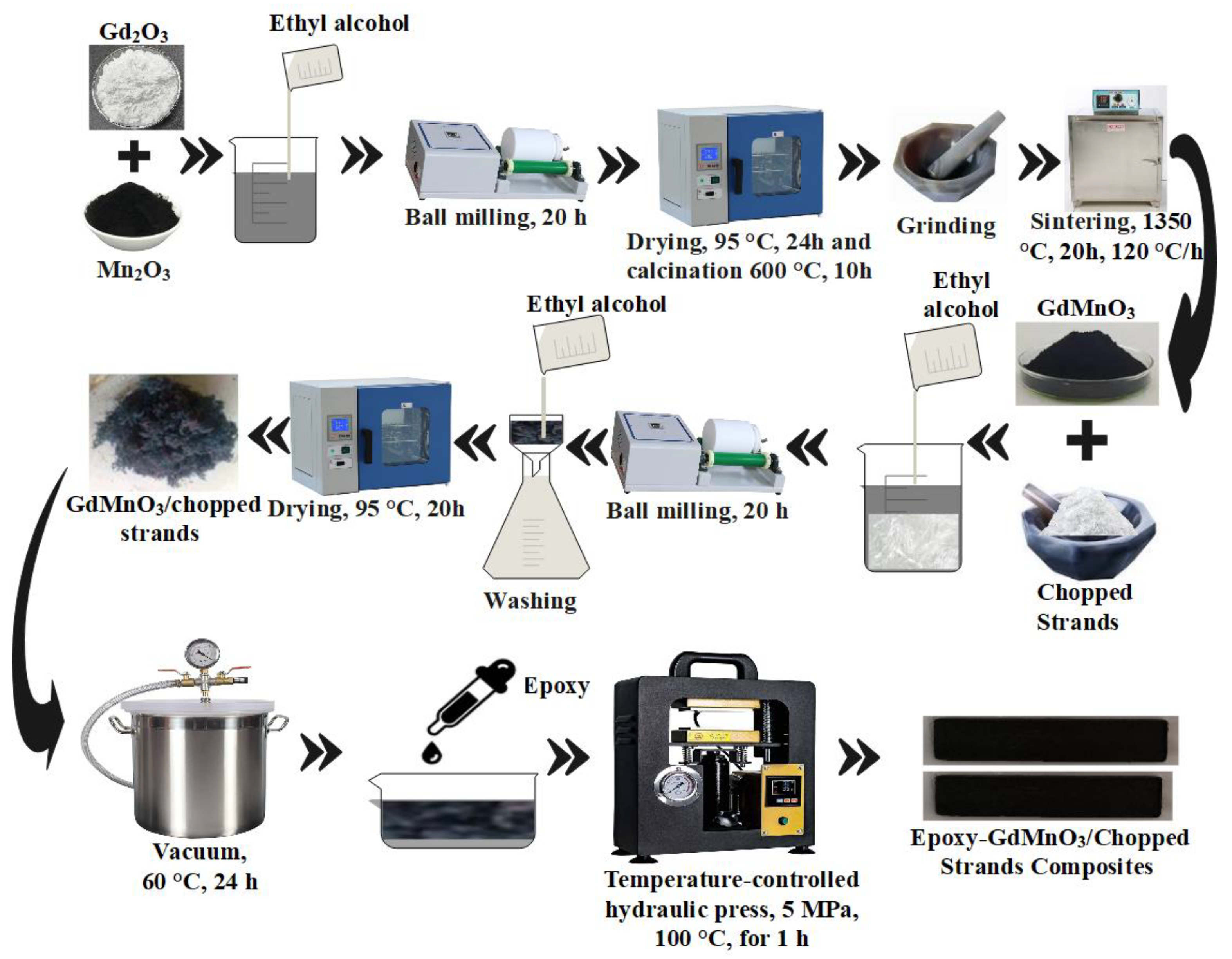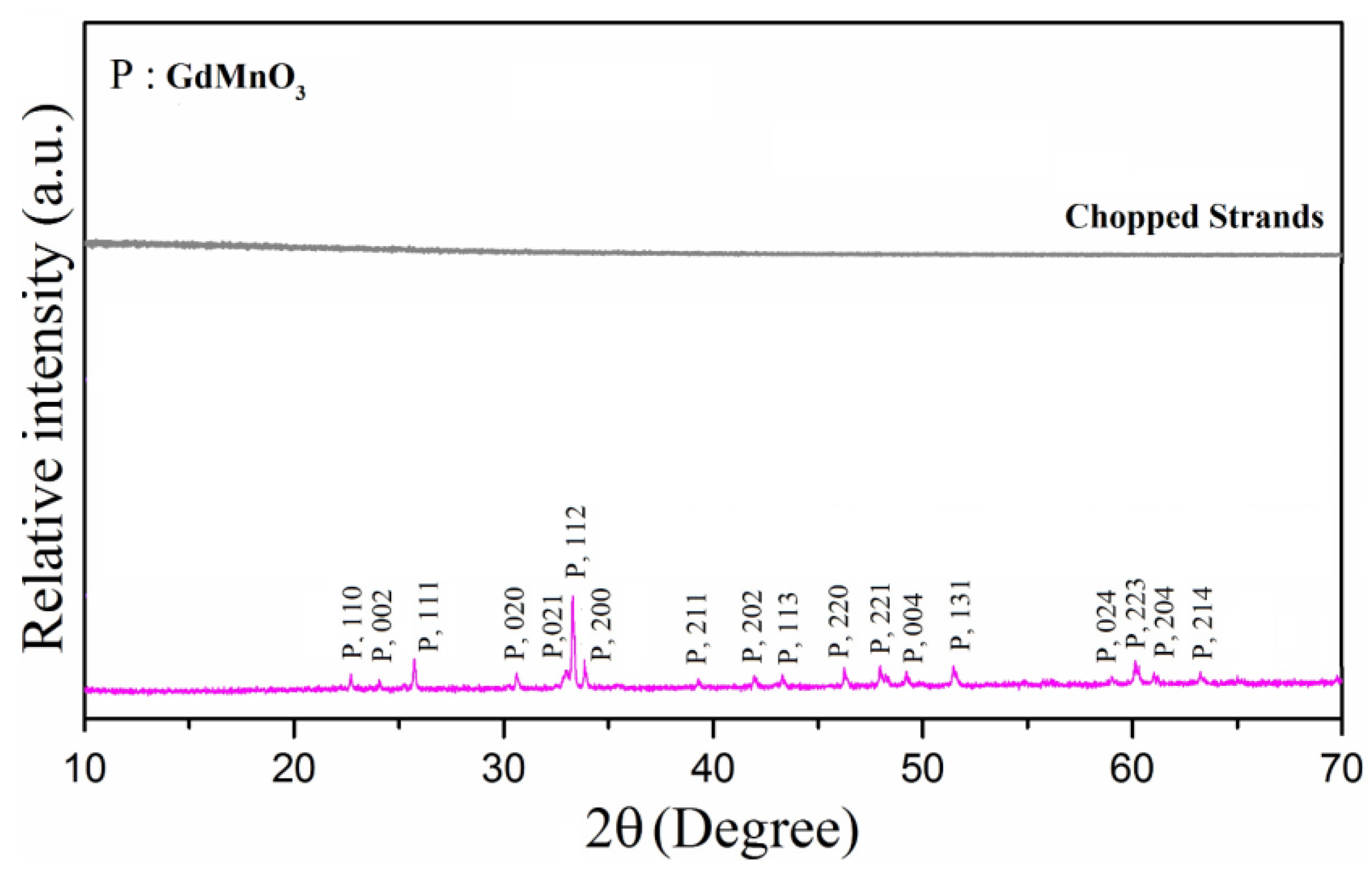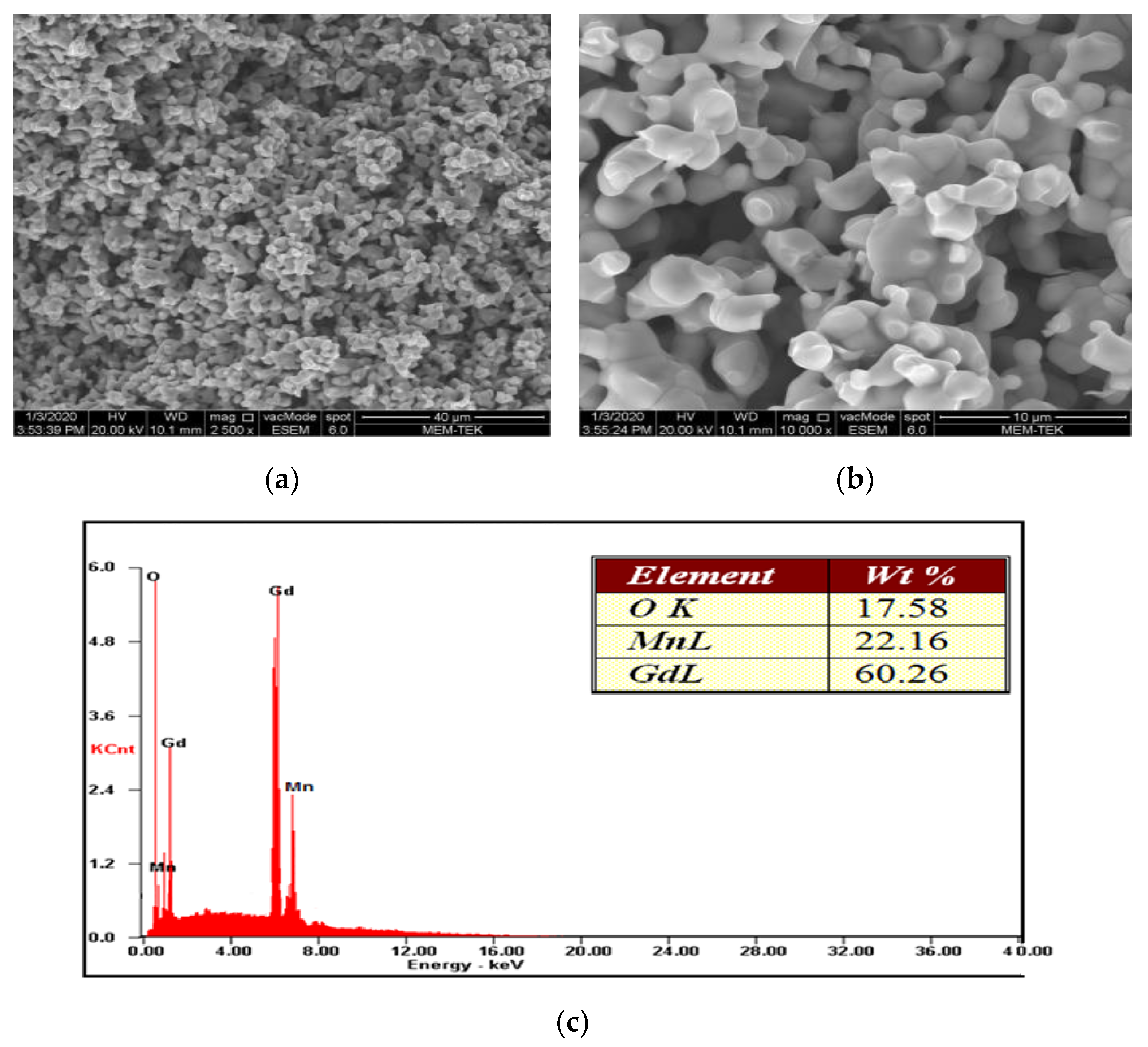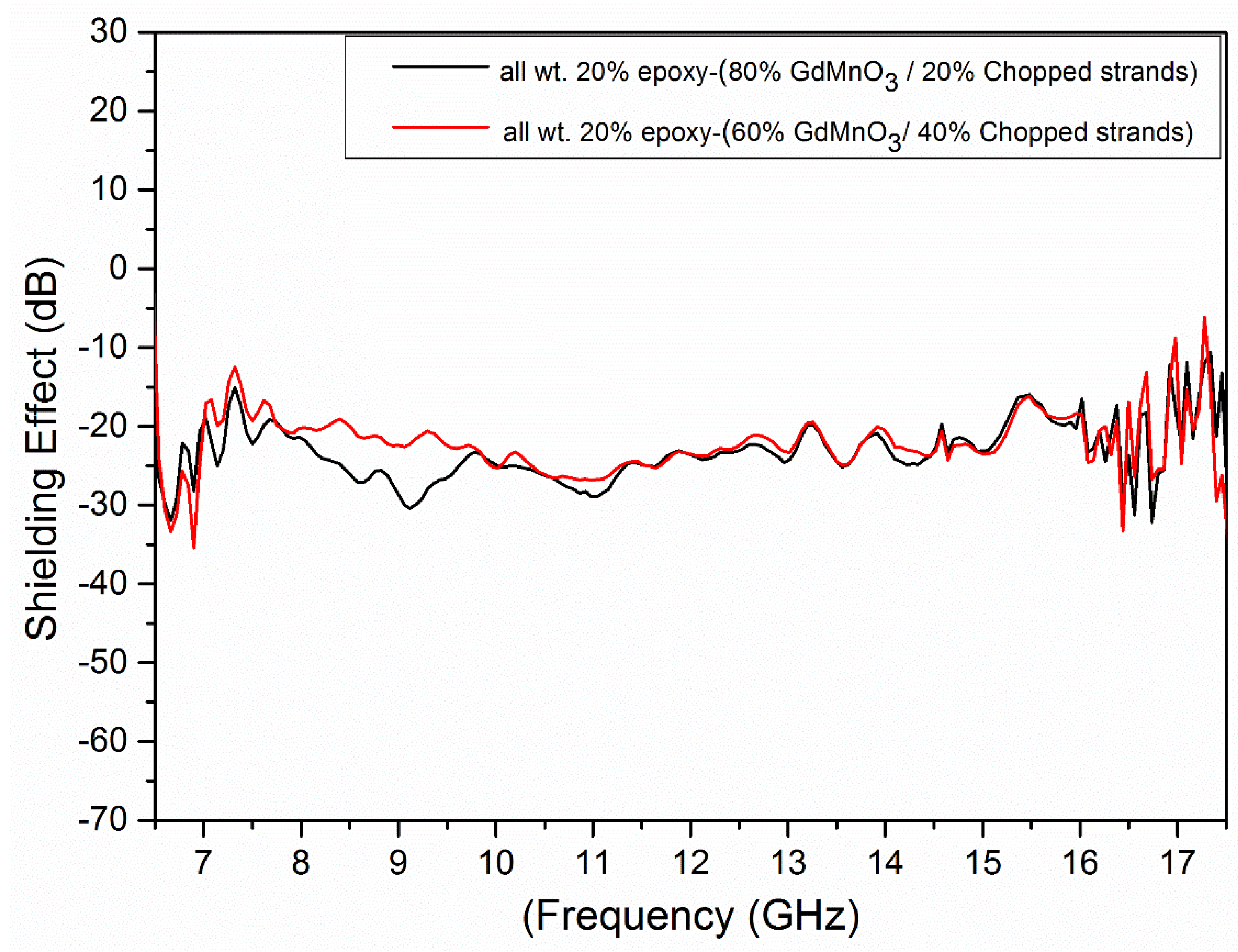Production and Shielding Effectiveness Features of Chopped Strands Backed-GdMnO3 Composites for 6.5–17.5 GHz Applications
Abstract
1. Introduction
2. Materials and Methods
2.1. Preparation of GdMnO3
2.2. Preparation of GdMnO3/Chopped Strands/Epoxy Composites
3. Results and Discussion
3.1. XRD Analysis of GdMnO3/Chopped Strands
3.2. SEM Analysis of GdMnO3
3.3. EMI Shielding Measurements of GdMnO3/Chopped Strands
3.4. Future Research Directions and Study Limitations
4. Conclusions
Author Contributions
Funding
Informed Consent Statement
Data Availability Statement
Acknowledgments
Conflicts of Interest
References
- Lalan, V.; Ganesanpotti, S. Boradband electromagnetic response and enhanced microwave absorption in carbon black and magnetic Fe3O4 nanoparticles reinforced polyvinlide nefluoride composites. J. Electron. Mater. 2020, 49, 1666–1676. [Google Scholar] [CrossRef]
- Abbas, S.M.; Dixit, A.K.; Chatterjee, R. Complex permittivity, complex permeability and microwave absorption properties of ferrite-polymer composites. J. Magn. Mater. 2007, 309, 20–24. [Google Scholar] [CrossRef]
- Şahin, E.İ.; Emek, M. Elektromanyetik kirlilik ortamında Kaolinit/PVA kompozitlerin elektromanyetik kalkanlama özellikleri. İstanbul Ticaret Üniversitesi Fen Bilim. Derg. 2023, 22, 194–204. [Google Scholar] [CrossRef]
- Panagopoulos, D.J.; Margaritis, L.H. The effect of exposure duration on the biological activity of mobile telephony radiation. Mutat. Res. /Genet. Toxicol. Environ. Mutagen. 2010, 699, 17–22. [Google Scholar] [CrossRef]
- Zaroushani, V.; Khavanin, A.; Mortazavi, S.; Jnonidi, A.; Moieni, M.; Javadzadeh, M. The role of a new electromagnetic shielding in reducing the microwave radiation for the x-band frequencies. Iran Occup. Health 2015, 12, 83–99. [Google Scholar]
- Jie, H.; Zhao, Z.; Zeng, Y.; Chang, Y.; Fan, F.; Wang, C.; See, K.Y. A review of intentional electromagnetic interference in power electronics: Conducted and radiated susceptibility. IET Power Electron. 2024, 17, 1487–1506. [Google Scholar] [CrossRef]
- Şahin, E.İ.; Emek, M. Elektromanyetik ekranlama uygulamaları için GdMnO3/PANI/Ba(Zn1/3Nb2/3)O3 kompozitlerin özellikleri. J. Inst. Sci. Technol. 2023, 13, 2143–2154. [Google Scholar]
- Liu, L.; Bian, X.M.; Hou, Z.L.; Wang, C.Y.; Li, Z.S.; Hu, H.D.; Qi, X.; Zhang, X. Electromagnetic response of magnetic graphene hybrid fillers and their evolutionary behaviors. J. Mater. Sci. Mater. Electron. 2016, 27, 2760–2772. [Google Scholar] [CrossRef]
- Kumar, S.; Ohlan, A.; Kumar, P.; Verma, V. Improved Electromagnetic Interference Shielding Response of Polyaniline Containing Magnetic Nano-ferrites. J. Supercond. Nov. Magn. 2020, 33, 1187–1198. [Google Scholar] [CrossRef]
- Ganguly, S.; Bhawal, P.; Ravindren, R.; Das, N.C. Polymer nanocomposites for electromagnetic interference shielding: A review. J. Nanosci. Nanotechnol. 2018, 18, 7641–7669. [Google Scholar] [CrossRef]
- Wu, Y.; Wang, Z. Progress in Ionizing Radiation Shielding Materials. Adv. Eng. Mater. 2024, 26, 2400855. [Google Scholar] [CrossRef]
- Shahzad, F.; Alhabeb, M.; Hatter, C.B.; Anasori, B.; Hong, S.M.; Koo, C.M.; Gogotsi, Y. Electromagnetic interference shielding with 2D transition metal carbides (MXenes). Science 2016, 353, 1137–1140. [Google Scholar] [CrossRef] [PubMed]
- Şahin, E.İ. Electromagnetic shielding effectiveness of Ba(Zn1/3Nb2/3)O3: Chopped strands composites for wide frequency applications. J. Ceram. Process. Res. 2023, 24, 190–196. [Google Scholar]
- Hamouni, M.; Heddar, S.; Ansri, A.; Khaldi, S. A comparative study of electromagnetic shielding efficiency of composites conducting polymers in near and far-fields. J. Mater. Environ. Sci. 2014, 5, 945–950. [Google Scholar]
- Shukla, V. Role of spin disorder in magnetic and EMI shielding properties of Fe3O4/C/PPy core/shell composites. J. Mater. Sci. 2020, 55, 2826–2835. [Google Scholar] [CrossRef]
- Liu, Y.; Zeng, Z.; Zheng, S.; Qiao, J.; Liu, W.; Wu, L.; Liu, J. Facile manufacturing of Ni/MnO nanoparticle embedded carbon nanocomposite fibers for electromagnetic wave absorption. Compos. Part B-Eng. 2022, 235, 109800. [Google Scholar] [CrossRef]
- Peng, L.; Liu, D.; Cheng, H.; Zhou, S.; Zu, M. A multilayer film based selective thermal emitter for infrared stealth technology. Adv. Opt. Mater. 2018, 6, 1801006. [Google Scholar] [CrossRef]
- Gao, S.; Zhang, Y.; Xing, H.; Li, H. Controlled reduction synthesis of yolk-shell magnetic@void@C for electromagnetic wave absorption. Chem. Eng. J. 2020, 387, 124149. [Google Scholar] [CrossRef]
- Wu, Y.; Zhao, Y.; Zhou, M.; Tan, S.J.; Peymanfar, R.; Aslibeiki, B.; Ji, G.B. The ultrabroad microwave absorption ability and infrared stealth property of nano-micro CuS@rGO lightweight aerogels. Nano-Micro Lett. 2022, 14, 171. [Google Scholar] [CrossRef] [PubMed]
- Wang, L.; Long, F.; Chen, Y.; Xiong, H.; Rehman, S.U.; Chang, J.; Zhong, Z. Optimization of the microwave absorption properties of FeSiCr@Fe2O3 core-shell nanoparticles by controlling the thickness and crystallinity of Fe2O3 shell. J. Am. Ceram. Soc. 2022, 105, 4171–4179. [Google Scholar] [CrossRef]
- Guo, T.; Xu, G.; Tan, S.; Liu, N.; Zhang, J.; Zeng, X.; Liang, J. First-principle calculations and experimental investigation on the infrared emissivity property of Mg-doped ZnO. Mater. Res. Bull. 2017, 95, 354. [Google Scholar] [CrossRef]
- Wang, Y.; Di, X.; Chen, J.; She, L.; Pan, H.; Zhao, B.; Che, R. Multi-dimensional C@NiCo-LDHs@Ni aerogel: Structural and componential engineering towards efficient microwave absorption, anti-corrosion and thermal-insulation. Carbon 2022, 191, 625. [Google Scholar] [CrossRef]
- Chung, D.D.L. Electromagnetic interference shielding effectiveness of carbon materials. Carbon 2001, 39, 279–285. [Google Scholar] [CrossRef]
- Jian, X.; Wu, B.; Wei, Y.; Dou, S.X.; Wang, X.; He, W.; Mahmood, N. Facile synthesis of Fe3O4/GCs composites and their enhanced microwave absorption properties. ACS Appl. Mater. Interf. 2016, 8, 6101–6109. [Google Scholar] [CrossRef]
- Liu, X.; Geng, D.; Shang, P.; Meng, H.; Yang, F.; Li, B.; Kang, D.; Zhang, Z. Fluorescence and microwave-absorption properties of multi-functional ZnO-coated alpha-Fe solid-solution nanocapsules. J. Phys. D-Appl. Phys. 2008, 41, 175006. [Google Scholar] [CrossRef]
- Liu, P.B.; Huang, Y.; Wang, L.; Zong, M.; Zhang, W. Hydrothermal synthesis of reduced graphene oxide-Co3O4 composites and the excellent microwave electromagnetic properties. Mater. Lett. 2013, 107, 166–169. [Google Scholar] [CrossRef]
- Li, D.; Liao, H.Y.; Kikuchi, H.; Liu, T. Microporous Co@C nanoparticles prepared by dealloying CoAl@C precursors: Achieving strong wideband microwave absorption via controlling carbon shell thickness. ACS Appl. Mater. Interfaces 2017, 9, 44704–44714. [Google Scholar] [CrossRef]
- Li, Y.; Shen, B.; Pei, X.; Zhang, Y.; Yi, D.; Zhai, W.; Zhang, L.; Wei, X.; Zheng, W. Ultrathin carbon foams for effective electromagnetic interference shielding. Carbon 2016, 100, 375–385. [Google Scholar] [CrossRef]
- Sahin, E.İ.; Ibrahim, J.E.F.; Emek, M.; Sinsoysal, B.; Amanzholova, A. Structural and shielding effectiveness properties of (NiFe2O4/chopped strands) composites for 6.5–18 GHz applications. J. Mater. Sci. Mater. Electron. 2024, 35, 1407. [Google Scholar] [CrossRef]
- Heryanto, H.; Siswanto, S.; Rahmat, R.; Sulieman, A.; Bradley, D.A.; Tahir, D. Nickel Slag/Laterite Soil and Nickel Slag/Iron Sand Nanocomposites: Structural, Optical, and Electromagnetic Absorption Properties. ACS Omega 2023, 8, 18591–18602. [Google Scholar] [CrossRef]
- Caramitu, A.R.; Ciobanu, R.C.; Ion, I.; Schreiner, C.M.; Aradoaei, M.; Tsakiris, V.; Pintea, J.; Marinescu, V. Flexible Electromagnetic Shielding Nano-Composites Based on Silicon and NiFe2O4 Powders. Polymers 2023, 15, 2447. [Google Scholar] [CrossRef]
- Şahin, E.İ.; Emek, M.; Ibrahim, J.E.F.M. Instrumental Measurements Laboratory, 1st ed.; Iksad Publishing House: Ankara, Turkey, 2023. [Google Scholar] [CrossRef]
- Guedri, A.; Hcini, S.; Alzahrani, B.; Boudard, M.; Dhahri, A.; Bouazizi, M.L. Sintering Temperature Effects on Structural, Magnetic, Magnetocaloric and Critical Properties of Nd0.67Pb0.33Mn0.9Al0.1O3 Manganites. J. Supercond. Nov. Magn. 2020, 33, 1223–1230. [Google Scholar] [CrossRef]
- Omari, L.H.; Zaim, M.; Hlil, E.K.; Kerouad, M.; Lekdadri, A.; Zaim, A. Critical Behavior and Magnetic Properties of Manganite-Derived Oxide La0.67Sr0.33MnO3: A Monte Carlo Study. J. Supercond. Nov. Magn. 2020, 33, 1103–1110. [Google Scholar] [CrossRef]
- Ye, F.; Dai, H.; Wang, M.; Chen, J.; Li, T.; Chen, Z. The structural; dielectric, and magnetic properties of GdMnO3 multiferroic ceramics. J. Mater. Sci. Mater. Electron. 2020, 31, 3590–3597. [Google Scholar] [CrossRef]
- Ibrahim, J.E. Enhancement of Structural and Magnetic Properties of Eu and Fe Doped GdMnO3 and Cr Doped HoMnO3 Multiferroic Ceramics. Master’s Thesis, Marmara University Institute For Graduate Sturdies In Pure and Applied Sciences, İstanbul, Turkey, 2015. [Google Scholar]
- Ibrahim, J.F.M.; Mergen, A.; Sahin, E.İ.; Basheer, H.S. The effect of europium doping on the structural and magnetic properties of GdMnO3 multiferroic ceramics. Adv. Ceram. Prog. 2017, 3, 1–5. [Google Scholar]
- Wang, M.; Wang, R.; Dai, H.; Li, T.; Chen, J.; Liu, D.; Yan, F.; Chen, D. The structure, optical and magnetic properties of GdMnO3 nano ceramics induced by aluminum substitution. J. Magn. Magn. Mater. 2022, 553, 169256. [Google Scholar] [CrossRef]
- Shayed, M.A.; Cherif, C.; Hund, R.D.; Cheng, T. Carbon and glass fibers modified by polysilazane based thermal resistant coating. Text. Res. J. 2010, 80, 1118–1128. [Google Scholar] [CrossRef]
- Zhao, F.M.; Takeda, N. Effect of interfacial adhesion and statistical fiber strength on tensile strength of unidirectional glass fiber/epoxy composites part I: Experiment results. Compos. Part A Appl. Sci. Manuf. 2000, 31, 1203–1214. [Google Scholar] [CrossRef]
- Singh, B.P.; Choudhary, V.; Saini, P.; Mathur, R.B. Designing of epoxy composites reinforced with carbon nanotubes grown carbon fiber fabric for improved electromagnetic interference shielding. AIP Adv. 2012, 2, 022151. [Google Scholar] [CrossRef]
- Bhardwaj, P.; Grace, A.N. Antistatic and microwave shielding performance of polythiophene-graphene grafted 3-dimensional carbon fibre composite. Diam. Relat. Mater. 2020, 106, 107871. [Google Scholar] [CrossRef]
- Santhosi, B.V.S.R.N.; Ramji, K.; Rao, N.B.R.M. Design and development of polymeric nanocomposite reinforced with grapheme for effective EMI shielding in X-band. Phys. B Condens. Matter 2020, 586, 1–9. [Google Scholar]
- Gallagher, K.J.; McCarthy, G.J. ICDD Grant-in-Aid; Penn State University: University Park, PA, USA, 1973. [Google Scholar]
- Priyadarshinee, S.; Pati, J.; Mahapatra, R. Studies of structural; microstructural, optical and dielectric properties of GdMnO3. J. Korean Ceram. Soc. 2023, 60, 203–214. [Google Scholar] [CrossRef]
- Sahu, D.; Panwar, R. Firefly Algorithm-Driven Development of Resistive Ink-Coated Glass and Mesh Fibers for Advanced Microwave Stealth and EMI Shielding Applications. J. Electron. Mater. 2024, 53, 7140–7151. [Google Scholar] [CrossRef]
- Aripin, A.B.; Sasongko, N.A.; Purqon, A.; Hayakawa, K. Fabrication and Evaluation of an Electromagnetic Shielding Material Made of Randomly Chopped Tape Carbon Fiber/Polyamide 6 Composites. J. Phys. Conf. Ser. 2024, 2866, 012004. [Google Scholar] [CrossRef]




| Sample | a (Å) | b (Å) | c (Å) | Volume (Å3) | Space Group |
|---|---|---|---|---|---|
| GdMnO3 | 5.840 | 7.430 | 5.310 | 230.41 | Pnma (62) |
| Sample | SE (dB) | Frequency (GHz) |
|---|---|---|
| All wt. 20% epoxy- (80% GdMnO3/20% chopped strands) | −32.54 | 16.74 |
| −32.04 | 6.65 | |
| −30.63 | 9.11 | |
| −29.2 | 11.01 | |
| −31.34 | 16.56 | |
| −10 | 6.5–17.5 | |
| −20 | 0–6.98 | |
| 7.78–13.19 | ||
| 13.32–14.55 | ||
| 14.59–15.16 | ||
| 16.07–16.32 | ||
| 16.39–16.59 | ||
| 16.66–16.86 | ||
| −30 | 6.61–6.69 | |
| All wt. 20% epoxy- (60% GdMnO3/40% chopped strands) | −35.61 | 6.9 |
| −33.71 | 6.67 | |
| −33.47 | 16.43 | |
| −29.67 | 17.4 | |
| −27.06 | 16.74 | |
| −10 | 6.5–16.93 | |
| −20 | 6.5–6.96 | |
| 8.51–13.09 | ||
| 13.32–13.84 | ||
| 14.01–15.22 | ||
| 16.05–16.18 | ||
| 16.74–16.86 | ||
| −30 | 6.59–6.71 |
Disclaimer/Publisher’s Note: The statements, opinions and data contained in all publications are solely those of the individual author(s) and contributor(s) and not of MDPI and/or the editor(s). MDPI and/or the editor(s) disclaim responsibility for any injury to people or property resulting from any ideas, methods, instructions or products referred to in the content. |
© 2025 by the authors. Licensee MDPI, Basel, Switzerland. This article is an open access article distributed under the terms and conditions of the Creative Commons Attribution (CC BY) license (https://creativecommons.org/licenses/by/4.0/).
Share and Cite
Emek, M.; Şahin, E.İ.; Ibrahim, J.E.F.M. Production and Shielding Effectiveness Features of Chopped Strands Backed-GdMnO3 Composites for 6.5–17.5 GHz Applications. Materials 2025, 18, 863. https://doi.org/10.3390/ma18040863
Emek M, Şahin Eİ, Ibrahim JEFM. Production and Shielding Effectiveness Features of Chopped Strands Backed-GdMnO3 Composites for 6.5–17.5 GHz Applications. Materials. 2025; 18(4):863. https://doi.org/10.3390/ma18040863
Chicago/Turabian StyleEmek, Mehriban, Ethem İlhan Şahin, and Jamal Eldin F.M. Ibrahim. 2025. "Production and Shielding Effectiveness Features of Chopped Strands Backed-GdMnO3 Composites for 6.5–17.5 GHz Applications" Materials 18, no. 4: 863. https://doi.org/10.3390/ma18040863
APA StyleEmek, M., Şahin, E. İ., & Ibrahim, J. E. F. M. (2025). Production and Shielding Effectiveness Features of Chopped Strands Backed-GdMnO3 Composites for 6.5–17.5 GHz Applications. Materials, 18(4), 863. https://doi.org/10.3390/ma18040863







